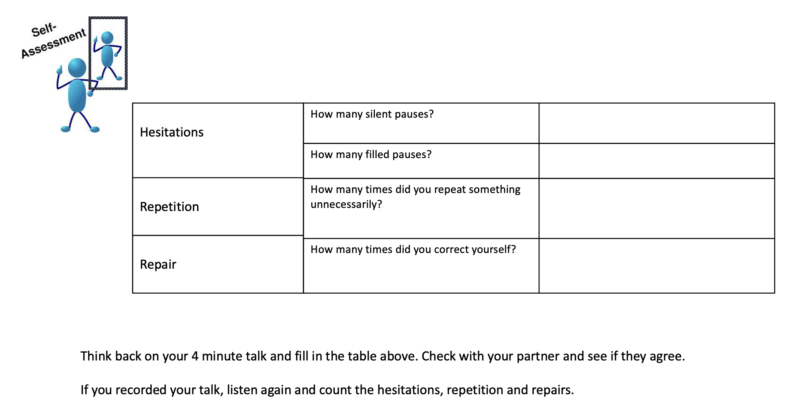Improving Fluency – The 4/3/2 technique, self-assessment and soliquizing
I’m working on another pre-sessional course this summer for a British university. I love pre-sessionals, for me it’s the only time of year I work with other teachers. The students are great too, usually very focused and excited at the prospect of studying abroad.
This year we need to focus on fluency in speaking. We seem to hope fluency will improve with time, exposure and growing confidence. It appears to me the activities I usually do are inadequate, they tend to be designed to improve fluency over the longer term by building vocabulary (paraphrasing, using vague language, or functional phrases to buy time, to generalize etc.) or they focus on improving accuracy, or both. I want activities that activate language the students already know.
This is an 8-week course with students of about B2 level, many of whom have spoken little in English classes more focused on grammar and writing.
I want to build fluency (not accuracy, particularly), to build confidence, and to give students a practice that is not teacher-dependent, which they can continue to use.
An internet search has led me to the 4/3/2. Proposed by K. Maruice in 1983 (TESOL Newsletter 17, p.429 The Fluency Workshop), the 4/3/2 goes like this:
- Put students into pairs. Give them a topic or question. Give them a minute to think about what they want to say.
- Give each student 4 minutes to speak.
- Swap partners. They now have 3 minutes to convey the same content.
- Swap partners. They now have 2 minutes to convey the same content.
See Improving Spoken Fluency by Paul Nation (1989) System, Vol 17. No. 3 (https://www.wgtn.ac.nz/lals/resources/paul-nations-resources/paul-nations-publications/publications/documents/1989-Fluency.pdf)
Jardel Santos and Maria Ramirez-Avila, M, (2022, TESL-EJ, Vol. 26, No.2) combined this technique with self-assessment to good effect (https://tesl-ej.org/wordpress/issues/volume26/ej102/ej102a1/). Shang-En, Huang and Yeu-Ting Liu 2022, English Teaching and Learning, 47) combine the 4/3/2 with a soliquizing technique as a way of promoting learner autonomy.
I’m using it online with a class of 12 students and set it up it like this:
- Tell the students they need a stopwatch. They will talk for 4 minutes (then 3, then 2) exactly, without interruption, then stop, even if in mid-sentence.
- Put students in pairs and label each pair A or B. A will start. This is important to avoid students wasting time deciding who will go first (as I am outside the breakout rooms, I cannot otherwise know what stage they’re at).
- In the first pair the students will have 12 minutes: 4 minutes to talk and a minute or so to look at the fluency table. In the second pair they will have 10 minutes, then 8.
- Make sure they understand that they are talking about the same thing each time. They may vary words or grammar, they may add or drop parts, but the message should be the same.
- Show the fluency table, students copy or take a screenshot. It is not necessary to count hesitations, fillers etc. just to give an overall impression (e.g. ‘a lot’, ‘fewer’ etc.).
- Give the students a topic or question e.g. Why did you choose to study your subject and why at this university? Give them a minute or so to think about their response but they shouldn’t write any notes.
- Put them in breakout rooms. After 12 minutes swap one out into the next room. After 10 minutes swap again.
- I don’t visit the rooms as a. I don’t want to break concentration and b. I don’t want to turn it into an accuracy-focused activity but on completion when students are all back in the main room I ask whether anyone would share their 2 minute talk with the class.
It’s a big hit with my class. They all say they felt more able to express themselves and more confident by the final turn.
We discussed how they could use these techniques outside class. I think there’s value in silently rehearsing what you want to say, it may be more useful to record yourself, whether or not you listen back to it straight away. Using transcription software like Otter.ai turns the exercise into one that focuses on accuracy, but it could be useful to do that occasionally too.
I tried the same exercise with a one-to-one IELTS student in the same week. It was a flop. I think the fact that he was repeating each step with me as the listener caused him to change the message substantially each time, which completely defeated the purpose. I’ll have to think about how this might be successfully adapted to one-to-one classes. I wonder if it would work if each step was performed in a different lesson, or perhaps if key themes were noted after the first 4-minute speech.
Example Feedback Table






Leave a Reply
Want to join the discussion?Feel free to contribute!